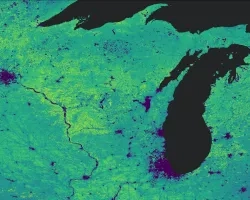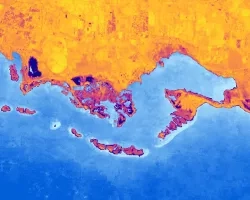Coastal regions in the northern Gulf of Mexico such as the Louisiana, Mississippi, and Texas coast are under the NASA measurements) will be integrated into the DST to provide 3-D ocean currents, temperature, salinity and sea level variations at 20 levels and a resolution of about 2 km for near-shore coastal waters. The enhanced DST using model and NASA results will provide information on storm surge, and effects (e.g., saltwater intrusion, flooding, water quality) on near-shore coastal environments (e.g., bays, wetlands), and change detection (associated with subsidence, sea level rise or vegetation change). The use of Geographical Information System (GIS) for monitoring the near-shore changes will provide managers and users with an efficient tool for decision making. Our objectives are to use a system engineering approach to critically re-evaluate relevant NASA results and assure its integration into the DST. We plan to develop a web site with integrated GIS and database capabilities for wider access and dissemination of information. Benchmarking the existing DST and transitioning to a Gulf Coast system by integrating the NASA products and model to multiple users (e.g., WAVCIS, National Data Buoy Center-NDBC, National Wetland Research Center-NWRC, Louisiana Department of Natural Resources-DNR, and Mineral Management Services-MMS) will leverage funding and facilitate the integration of NASA Earth science data for coastal management and decision making. Implementation of this system in an environment dominated by the largest river system in North America will potentially allow for its transition to other deltaic regions and optimize the use of NASA Earth-Sun System science research results to meet national needs. The project will also provide the research structure and financial support for training undergraduate and graduate students. combined threat of subsidence, wetland loss, energetic meteorological events and human induced changes to the ecosystem. Emergencies such as the landfall of a hurricane, or an oil spill can have a strong impact on a coastal ecosystem or community. For example, the landfall of hurricane hurricanes Katrina and Rita have considerably impacted coastal communities and ecosystems, reduced the capacity of oil industry, with consequences felt by the US economy and throughout the world. In such a fragile environment, emergencies pose complex decision problems. To address this issue, both state and Federal Governments have passed legislations to address these emergencies associated with storm surge and mitigate loss of coastal wetlands and ecosystems. A storm surge decision support tool (DST) in operation for coastal Louisiana and Mississippi utilizes field data from the Wave- Current-Surge Information System (WAVCIS) at Coastal Studies Institute (CSI), Louisiana State University (LSU) which provides near real-time field met-ocean data (wind, currents, temperature, sea level and waves). Information from the WAVCIS system will be enhanced to include data from NDBC buoys along the Louisiana and Texas coast and the assimilation of several NASA Earth science products and data: i) winds from Seawinds on QuickSCAT, ii) sea surface temperature (SST), total suspended matter (TSM), Chlorophyll (Chl), Colored Dissolved Organic Matter (CDOM), and reflectance data from MODIS on Terra and Aqua, and iii) Sea Surface Height (SSH) from Jason-1. The output of an NRL nested coastal model (NCOM) of the Gulf coast (that uses
Project


